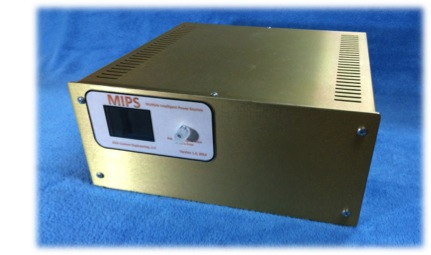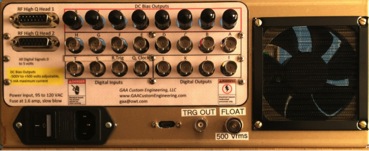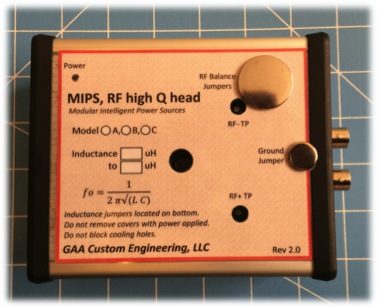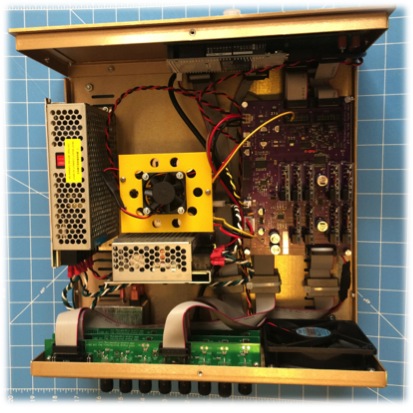Technical resources
- Details
- Category: GAACE
- Published on Monday, 19 September 2016 12:43
- Written by Administrator
- Hits: 6942
Technical resources
GAACE provides a number of technical resources and this page provides links to what is available. This page also describes how you can upgrade the firmware in your MIPS system.
All source code for the MIPS system and for the MIPS host application can be found on my github account here. You will also find a number of useful documents on this drive and we try to keep this up to date.
All MIPS updated firmware versions and host MIPS app install files can be found on my google drive here.
All technical data for my products are available on this google drive.
If you own a MIPS system and would like to upgrade the firmware to the most current version please visit this google dive. You will find details on how to install the MIPS host application and how to update the firmware. You will also find the most current version of the firmware.
Here are a few useful documents that I have linked:
MIPS application examples
- Details
- Category: GAACE
- Published on Monday, 19 September 2016 12:34
- Written by Administrator
- Hits: 7460
MIPS Application Examples
MIPS systems are in use in a number of laboratories to support a variety of research applications. Listed below are several of these laboratories with links to their site to learn more about their research.
James Bruce’s lab at the University of Washington
Dr. Bruce’s pioneering developments in parallel excitation and detection of ion by FTICR is an example of MIPS system integration with a commercial mass spectrometer and generation of complex pulse sequence. In this example MIPS is trigger by the mass spectrometer and generates the required timing, this research also used MIPS ability to execute multiple pulse sequences and the experiment evolves.
Alexandre Shvartsburg’s lab at Wichita State University
Dr. Shvartsburg’s research in FAIMS has resulted in continuous advancements of the field. GAACE has developed MIPS based FAIMS power supplies to support his exciting research. The MIPS supply was used for the research that was featured on the cover of JASMS May 2016 issue.
Matt Bush’s lab at the University of Washington
Dr. Bush’s research group has developed and applied SLIM technology toward their research in large proteins research elucidating collisional cross sectional values. This research was supported using MIPS systems to generate required RF/DC voltages as well as pulse sequence generation.
GAACE worked with Dr. Clowers to develop an open source BN gate pulse generator to support his research as well as provide capability to the research community. This is an excellent example of research collaboration.
Spectroglyph has design and developed exciting new MALDI imaging capability. GAACE provided a customized MIPS system to provide the needed RF/DC voltages as well as pulse sequence generation that this system required.
Pacific Northwest National Laboratory (PNNL)
The SLIM research developed at PNNL is an excellent example of MIPS systems in action. The SLIM research falls into two main areas, conventional ion mobility separation and traveling wave mobility separation. My goggle scholar page lists a number of papers and patents that describe this research, also follow the citations to see work from other labs in this area. All the traveling wave SLIM research has been done using MIPS systems. I have been closely involved in this development as can be seen from my name on many of the patents and papers. There are licensing options available for SLIM at PNNL, please see this link to learn more of opportunities. I have a number of ideas that could expand the capability and provide additional IP. If you are interested in pursuing research in this area I would love to discuss ways we might partner. Our MIPS products will provide all the control electronics needed to get you started and provide a platform for your growth.
SLIM technology will allow detection of ions with a simple current amplifier. This has great potential but also challenges due to all the RF voltages and Twave switching voltages present in the system. GAACE has done a great deal of work in the area of low noise detection and has ideas that could provide unique high performance detection capability. This would allow the development of portable SLIM based systems for a wide range of applications.
MIPS systems are very versatile and can be configured for many mass spec research activities. We are always happy to discuss your application and how our capabilities can help. Our specialty is research and we aim our products toward research institutions. We know you will find our rates the most competitive in the industry.
GAACE is very interested in supporting and promoting mass spec research. This community has provided us a very rewarding career and allowed us to provide research support to the community at very low rates. If you need help with a project please call, even if all you want to do is discuss your problem and get ideas to move your project forward. We are also interested in doing pro bono work if you have the right problem and cause we may be interested in contributing. Our strength is in circuit design and real-time control of systems so give us a call I bet we can help you move your project forward!
New Products!
GAA Custom Engineering, LLC has developed a line of products supporting instrument development research in the mass spectrometer area. These products aim to provide monitoring and detection capabilities as well as specialized power sources designed to provide RF and DC waveforms needed to control mass spectrometer based instruments.
The products listed are available for purchase with lead times generally under 4 weeks. Please contact us if you have specialized needs. Your requirements may result in a product we are interested in producing and selling.
Ion current detection system, $195
This is a low cost sensitive current detector suitable for detecting both DC and pulsed ion currents. This device uses an electrometer opamp allowing small size and low cost.
-
- Sensitivity of one volt per nano amp
- Adjustable gain
- Adjustable bandwidth
- Detector offset adjustment of +- 10 volts
- BNC input and out connectors
- Minimal magnetic material in detection head, can be placed is high magnetic field to support FTICR application.
FTICR preamp, $295
This is a low cost FTICR preamp designed to detect ion image current. This is a differential amplifier with a single ended output capable of driving high speed digitizers.
Plainer ion manipulation electrode systems
We are designing and marketing a number of ion manipulation electrode systems supporting the research community. These systems are built using conventional PC board manufacturing capability. We have several designs in progress so please call or email to get more information and discuss your specific needs
Planer moving wave, $995
This is a set of four PC boards that can be used to confine and manipulate ions. Two of these boards are placed in parallel (one over the next with the electrodes facing each other) and placed into a vacuum system. Ions can then be injected between the boards and with the proper application of RF and DC voltages these ions can be moved down the length of the device.
-
- Four 12” x 3” boards allowing two 12” systems to be assembled
- All exposed electrode gold plated
- 0.062” board thickness
- FR4 board material
- All electrode spacing 0.005”
Planer moving wave experimenters kit, $1895
This is a set of four PC boards that can be used to confine and manipulate ions. Two of these boards are placed in parallel (one over the next with the electrodes facing each other) and placed into a vacuum system. Ions can then be injected between the boards and with the proper application of RF and DC voltages these ions can be moved down the length of the device. This experimenters kit contains four different ion lanes using different electrode configurations. One of the lanes contains a "zig-zag" arrangement allowing control of the ion path.
-
- Four 12” x 4” boards allowing two 12” systems to be assembled
- All exposed electrode gold plated
- 0.062” board thickness
- FR4 board material
- All electrode spacing 0.005”
Planer moving wave long path length kit, $2980
This is a set of PC boards that contain a long serpentine path of moving wave electrodes. The total path length is over 28 meters. Two boards are placed in parallel (one over the next with the electrodes facing each other) and placed into a vacuum system. Ions can then be injected between the boards and with the proper application of RF and DC voltages these ions can be moved down the length of the device. This kit includes 3 pair of PC boards, 3 top and 3 bottom boards.
-
- Six 18.13” x 12.8” boards allowing three systems to be assembled
- All exposed electrodes gold plated
- 0.062” board thickness
- FR4 board material
- All electrode spacing 0.005”
Second Generation Planer moving wave long path length short kit, $1795
This is a set of PC boards that contain a long serpentine path of moving wave electrodes. The total path length is over 28 meters. Two boards are placed in parallel (one over the next with the electrodes facing each other) and placed into a vacuum system. Ions can then be injected between the boards and with the proper application of RF and DC voltages these ions can be moved down the length of the device. This kit includes 2 pair of PC boards, 2 top and 2 bottom boards.
-
- Four 18.09” x 12.8” boards allowing two systems to be assembled
- All exposed electrodes gold plated
- 0.062” board thickness
- FR4 board material
- All electrode spacing 0.005”
- Improved ion inlet and outlet position for easier interface to mass spectrometer
How to order from our New Products page
If you would like to order a product discribed on this page please contact us via This email address is being protected from spambots. You need JavaScript enabled to view it. with your needs and we will provide you an invoice that you can pay electronically. We would also be happy to discuss any specific custom needs you might have.
MIPS
- Details
- Category: GAACE
- Published on Monday, 06 October 2014 01:17
- Written by Administrator
- Hits: 8235
Introducing MIPS, Modular Intelligent Power Sources. MIPS is a modular system that can be configured to meet your power source needs. Specifically designed for Mass Spectrometry instrument development applications. This system can also be applied to other areas where multiple RF and DC sources are required.
Download a MIPS overview presentation.
Download the MIPS operations manual.
Download the FAIMS operations manual.

MIPS provides RF and DC voltage sources that can be controlled and monitored as well as generate complex voltage sequences enabling unique instrument control capabilities. The heart of the MIPS system is a powerful ARM processor used to control the hardware, monitor its status, and communicate with the user and or host-controlling computer. MIPS is customizable to your specific application and can be easily expanded as your control needs expand. Below is a list of the MIPS systems key features:
- RF and DC voltage sources to drive multi-poles, funnels, and ion optics
- Digital inputs (8) and outputs (16)
- Sequence control capability. Time dependent voltage profiles can be generated. These sequences can contain voltage profiles and digital output pulse sequences.
- Internal or external clock options
- Internal of external trigger options
- USB host computer interface allows full control of all options
- Simple front panel user interface with color graphics interface
- A maximum of 4 RF drives can be controlled by one MIPS system
- 500KHz to 5 MHz range depending on load
- Up to 500 Vp-p depending on load
- DC voltage generation
- Up to 16 total output channels, 8 per board, can be added to one MIPS system
- +- 50 volt board with programmable +- 50 volt offset allowing +- 100 volt control capability. 5-milliamp output current capability per channel. This supply can accept an external float input to offset all 8 of these supplies based on the float voltage provided.
- +- 250 volt board with programmable +- 250 volt offset allowing +- 500 volt control capability. 5-milliamp output current capability per channel. This supply can accept an external float input to offset all 8 of these supplies based on the float voltage provided.
- +- 750 volt board with programmable +- 750 volt offset allowing +- 1500 volt control capability. 3-milliamp output current capability per channel. This supply can accept an external float input to offset all 8 of these supplies based on the float voltage provided.
- FAMIS bi-sinusoidal driver
- ESI source controller with high voltage spray needle supply as well as inlet temperature controller.
MIPS can be configured to your application by selecting the options needed for your specific problem. Several options are available now with a number of new capabilities under development. The following list of MIPS options are under development at this time:
MIPS is housed in a 5” high 12” wide and 12” deep aluminum enclosure with standard connector on the rear panel. A MIPS system consists of the main chassis that includes the controller with digital IO as well as power supplies and IO connectors needed to support a number of optional IO cards.


The following IO cards and options are available:
- RF driver and RF High Q heads. This enables the MIPS system to drive RF multipoles as well as ion funnels etc. This option includes a card installed in the MIPS chassis; this card can drive two RF High Q heads. Additionally one of 2 High Q RF heads are required to drive your device. The High Q RF heads can be tailored to match the capacitance of your load.
- Eight channel DC power supplies. Several power supply options are available each with different voltage ranges and current drive capability. Addition DC power supplies are being developed so if you don’t see what you need please contact us.
- Traveling wave generator. This option will allow the MIPS system to generate an 8 channel pulsed output with adjustable output levels. Any digital pattern can be programmed into the output channels then an adjustable clock rotates the bit pattern through the 8 outputs in a continuous fashion.
Price list:
MIPS chassis (MIPS01) $1495
-
- Controller
- 5” x 12” x12” chassis (rack option at no additional cost)
- Power supplies
- Signal distribution
- Display and user interface
- USB interface
RF Driver (RFD01) $595
-
- Allows driving up to 2 High Q RF heads
High Q RF Head, Model A (HQRFA) $395
High Q RF Head, Model B (HQRFB) $395
-
- This module connects to the MIPS system when a RF driver board has been installed. Two heads can be attached to one RF driver board. Two High Q RF Heads are available, Model A and Model B. design to drive different capacitive loads.
High Power High Q RF Head (HPHQRF) $495
-
- This module connects to the MIPS system when a RF driver board has been installed. Two heads can be attached to one RF driver board. This RF head is designed to drive high capacitance loads or low capacitance loads at higer frequencies.
DC power supply, 8 channel +-50V (DC50) $495
-
- This module provides user programmable output voltages for each channel
- 8 output channels
- Source or sink up to 15 milliamps per channel
- Output voltage monitoring and display
- Output offset control to allow shifting the reference by +- 50 volts
- Output voltage error detection and system shutdown in the event of an error condition
- External float input
DC power supply, 8 channel +-250V (DC250) $895
-
- This module provides user programmable output voltages for each channel
- 8 output channels
- Source or sink up to 5 milliamps per channel
- Output voltage monitoring and display
- Output offset control to allow shifting the reference by +- 250 volts
- Output voltage error detection and system shutdown in the even of an error condition
- External float input
DC power supply, 8 channel +-750V (DC750) $1295
-
- This module provides user programmable output voltages for each channel
- 8 output channels
- Source or sink up to 3 milliamps per channel
- Output voltage monitoring and display
- Output offset control to allow shifting the reference by +- 750 volts
- Output voltage error detection and system shutdown in the even of an error condition
- External float input
Traveling Wave (TW02) $1295
-
- This module includes the Traveling Wave generation hardware as well as controllable power supplies providing two guard outputs and the Traveling Wave pulse voltage.
- 8 output Twave signals
- Voltage adjustable from 7 to 100 volts
- 2 programmable guard voltage
- User adjustable frequency
- External trigger input
- Twave sequence is user definable
- Twave direction is user definable
FAIMS (FAIMS01)
The FAIMS capability requires the addition of the FAIMS module (FAIMS01) to the MIPS chassis and a FAIMS RF Deck. The FAIMS module provides all the needed power drivers and frequency generation as well as DC voltages for bias and scanning function. The RF Deck develops the high voltage RF signals and couples the DC voltages to the RF.
The FAIMS power supplies and various options have limited avalibility, please contact us with your needs we will discuss options and avalibility and pricing.
Field Driven FAIMS (FAIMS02)
The FAIMS capability requires the addition of the FAIMS module (FAIMS01) to the MIPS chassis and a FAIMS RF Deck. The FAIMS module provides all the needed power drivers and frequency generation as well as DC voltages for bias and scanning function. The RF Deck develops the high voltage RF signals and couples the DC voltages to the RF. This Field Driven FAIMS module includes additioal DC supplies to drive a total of 4 DC outputs.
Field Driven FAIMS connection kit (FAIMSFDCK)
This connection kit includes two PC boards desiged to couple the RF and DC signals to the FAIMS device. Two boards are provided, one for each FAIMS electrode and the connectors.
FAIMS RF Deck (FAIMSRFD01)
The FAIMS RF Deck connects to a MIPS chassis equiped with a FAIMS module (FAIMS01).
How to order your MIPS system
If you would like to order a MIPS system please contact us via This email address is being protected from spambots. You need JavaScript enabled to view it. with your needs and we will provide you an invoice that you can pay electronically. We would also be happy to discuss any specific custom needs you might have. We have a number of configurations predefined so feel free to order using the options provided.
We also offer MIPS kits, these kits provide all the key components but they are not ready to use without some additional assemble by the customer. The AC power input module is not included with these kits but the part number is specified. If you build the MIPS kit option we recomend that you have the final system inspected by your electrical safety personley before use.
Upgrading your MIPS system
If you have a MIPS that you would like to upgrade please This email address is being protected from spambots. You need JavaScript enabled to view it. with your specific needs and we will provide you an invoice ,that you can pay electronically, for the upgrade. Please make sure to include details on your specific system and the new capability you would like to install. You have two options for this upgrade, you can send your MIPS system to us for upgrade or we can send you a kit that you can install. The kits comes with all the components you need and instalation instructions.

Contact Us
- Details
- Category: GAACE
- Published on Friday, 28 March 2014 12:03
- Written by Administrator
- Hits: 11796
GAA Custom Engineering, LLC
POB 335
Benton City, WA 99320
Gordon Anderson, Chief Engineer
509.588.5410
509.628.6851 (cell)
This email address is being protected from spambots. You need JavaScript enabled to view it.


